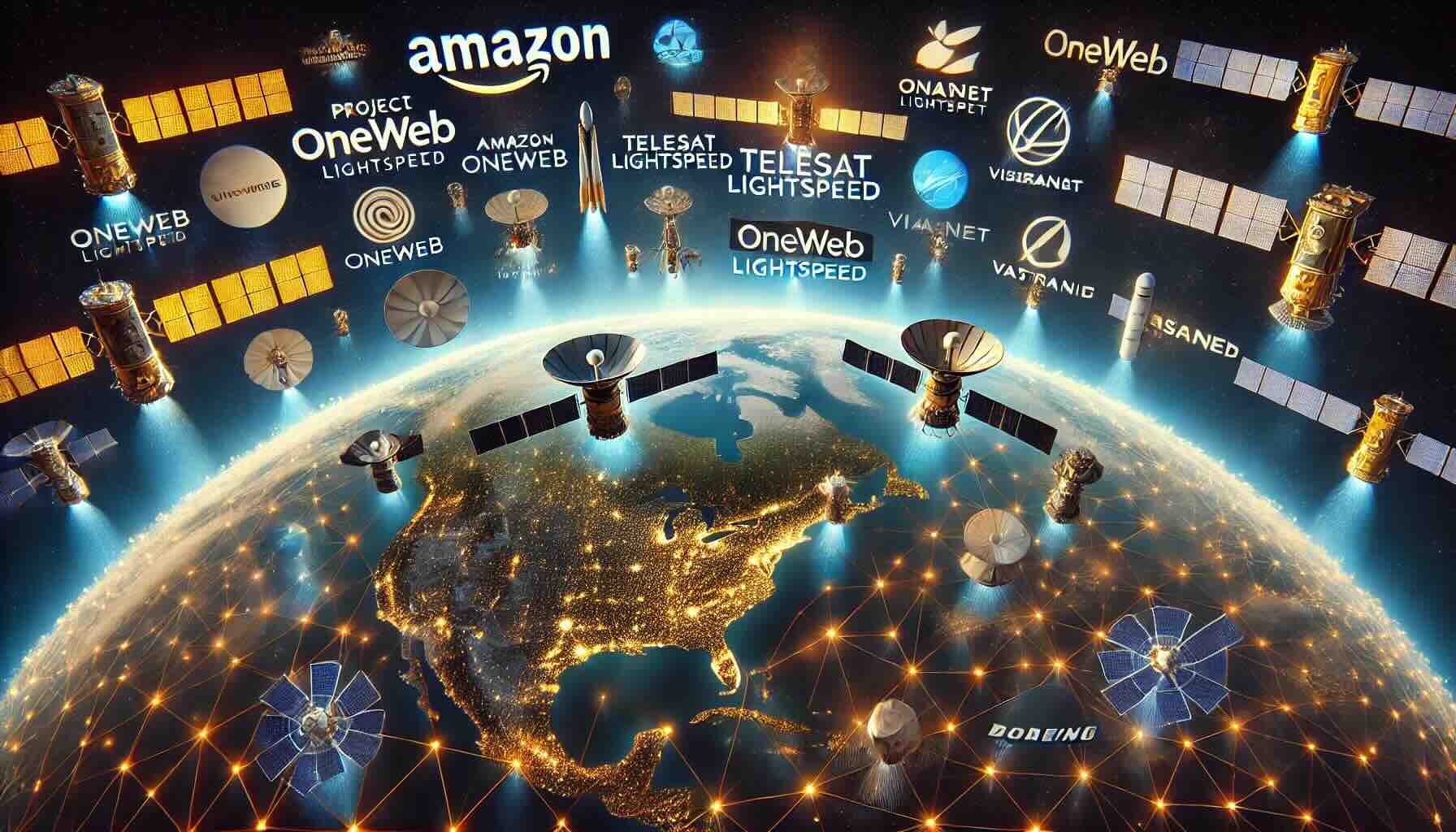Exploring Alternatives to Starlink: The Future of Satellite Internet

Expressing interest in holding the same space, several companies have moved to offer innovative satellite internet solutions that can take on SpaceX's Starlink as demand for internet connectivity takes off around the world. As such, each case in this blog will discuss the top contenders in the satellite Internet segment: Amazon's Project Kuiper, OneWeb, Telesat Lightspeed, Viasat, HughesNet, Astranis, Boeing, and O3b mPOWER by SES.
The satellite internet has grown to become a fast-evolving field since it promises high-speed internet access at the remotest corners of the world. Although Starlink takes up most of the attention, there are quite some companies making real progress in this area. This blog post is going to discuss players who strive for pole position in the burgeoning satellite Internet market, from Amazon's ambitious Project Kuiper to OneWeb's growing satellite constellation.
Exploring Alternatives to Starlink: The Future of Satellite Internet
The race for global satellite internet has heated up, but this does not shut down the role of SpaceX's Starlink; rather, it has several other companies that are joining in. These alternatives ride on cutting-edge technologies to beam high-speed connectivity out to remote and underserved areas worldwide. Here's a look at some of the most promising competitors:
Amazon's Project Kuiper
Amazon's Project Kuiper is intended to launch over 3,000 satellites into a constellation to offer high-speed internet coverage all across the globe. Now, with its regulatory clearances ready, Amazon is gearing up for the launch of its first satellites. The project will no doubt benefit from Amazon's rich resources and expertise in cloud computing to offer services that are competitive.
Read more about Project Kuiper
OneWeb
OneWeb is building out a satellite constellation to provide broadband services, particularly in remote and unserved areas. OneWeb has already launched several satellites, is commencing limited services, and has plans for massive coverage.
Learn more about OneWeb
Telesat Lightspeed
Canadian satellite operator Telesat is working on the Lightspeed constellation to deliver high-speed internet. With funding secured, Telesat is preparing for its initial satellite launches, aiming to provide low-latency, high-capacity internet services.
Explore Telesat Lightspeed
Viasat
Viasat offers satellite internet services through its existing geostationary satellites and plans to expand its capabilities with the Viasat-3 constellation. Already operational, Viasat continues to enhance its coverage and service quality.
Discover Viasat
HughesNet
HughesNet, primarily serving North America, provides satellite internet services using geostationary satellites. The company is operational and continually upgrading its technology to offer better speeds and reliability.
Check out HughesNet
Astranis
Astranis focuses on developing small, low-cost geostationary satellites to deliver targeted internet coverage to underserved regions. The company plans to launch its first commercial satellite soon, offering a unique approach to satellite internet.
Learn about Astranis
Boeing
Boeing has announced plans to build a constellation of satellites for broadband services. Currently in the early stages of development, Boeing's entry into the satellite internet market is backed by its extensive aerospace expertise.
Read about Boeing's plans
O3b mPOWER (SES)
SES’s O3b mPOWER network is a next-generation Medium Earth Orbit (MEO) satellite system designed to deliver high-speed, low-latency internet services. With launches planned, this network aims to enhance global connectivity significantly.
Explore O3b mPOWER
Alternative Options to Starlink: How Do They Compare?
With the satellite internet space in a flux, several companies are vying to offer global connectivity solutions. Just how the majors stack up against each other in terms of Amazon's Project Kuiper, OneWeb, Telesat Lightspeed, Viasat, HughesNet, Astranis, Boeing, and SES's O3b mPOWER has yet to be documented.

Coverage and Constellation Size
Starlink
- Constellation Size: ~12,000 satellites proposed
- Coverage: Global, with massive deployment in North America and Europe
Project Kuiper by Amazon
- Constellation Size: 3,236 satellites as
- Reach: Worldwide; focused at first on the under-served segments
OneWeb
- Constellation Size : Initial phase around 648 satellites, later possibly expanded up to 2
- Allocation: Global, with additional focus on remote and rural settlements
Telesat Lightspeed
- ** Constellation Size**: 298 satellites are planned
Coverage: Global, segmenting markets by enterprise and government sectors.
Viasat
- Constellation Size: Geostationary satellites (Viasat-1, Vias
- Reach: Primarily North America, but expanding globally with Viasat-3
HughesNet
- Size of a Constellation: Geost
- Range: North to northern region of South America
Astranis
- Size: Low Number GEO Satellites
Coverage: Areas targeted, with a focus on underserved areas
Boeing
- Size of Constellation: The plan is for several hundred
- Coverage: Global, with the emphasis on growing broadband area.
O3b mPOWER (SES)
- Size of the Constellation: 11 satellites, MEO, with more into the next phase ***
- Overage: Global, high-capacity, low-latency focused.
Speed and Latency
Starlink
- Velocity: 150 Mbps Maximum
- Latency: 20-40 ms
Project Kuiper from Amazon
- Speed could be just as speedy as fibre broadband
- Latency: Low, exact numbers not disclosed yet
OneWeb
- High-speed: Goes up to 50 Mbps at the moment, and even higher speed plans are in store.
- Latency: 30-50 ms
Telesat Lights
- Speed: Multi-Gbps capacity per satellite
- Latency: 30-50 ms
Viasat
- Speed: Up to 100 Mbps on Viasat-2, greater speeds on the horizon for Viasat-3
- Latency: This is higher (~ 600ms) due to geostationary orbit
HughesNet
- Speed: Up to 25 Mbps
- Latency: Higher latency due to geostationary orbits (~600 ms)
Astranis
- Velocity: Variable in deployment but expected to be high-speed.
- Latency: Same as other geostationary services (~600ms)
Boeing
- Velocity: information not fully divulged but expects to be great
- Latency: Low Latency focus
O3b mPOWER (SES)
- Speed: Multi-Gbps
- Latency: ~150 ms (MEO)
Market Focus
Starlink
- Focus Markets: Customer, Remote, Marine and Aeronautical Segments
Amazon's Project Kuiper
- Market Focus: Consumer, Schools, Business, and Public Sector
OneWeb
- Market Focus : Remote areas, Maritime, Aviation, Government, Enterprise
Telesat Lightspeed
- Market Focus : Businesses, Government and Telecommunication service providers
Viasat
- Market Focus: Consumer, Aviation, Maritime, Government
HughesNet
- Market Focus: Rural consumers and small businesses
Astranis
- Market Focus: Certain underserved regions, developing countries
Boeing
- Market Focus: General broadband market; in underserved areas
**O3b mPOWER
- Market Focus: Enterprises, Telecom operators, and Government sectors
Cost and Availability
Starlink
- Cost: $499 for the hardware, $99/month subscription
- Accessibility: Available in multiple countries, expanding rapidly
Amazon's Project Kuiper
- Cost: Expected to be competitive, details not yet disclosed
- Accessibility: Initial deployment planned for underserved regions
OneWeb
- Cost: Pricing varies based on service and region
- Accessibility: Limited service available, expanding coverage
Telesat Lightspeed
- Cost: Targeted at enterprise and government clients, pricing not disclosed
- Accessibility: Service expected post-launch
Viasat
- Cost: $50-$150/month based on plan
- Accessibility: Available primarily in North America, expanding globally
HughesNet
- Cost: $60-$150/month based on plan
- Accessibility: Available in North America and parts of South America
Astranis
- Cost: Expected to be competitive, details not yet disclosed
- Accessibility: Targeted deployments in specific regions
Boeing
- Cost: Details not yet disclosed
- Accessibility: Plans for global coverage
O3b mPOWER (SES)
- Cost: Targeted at enterprise and telecom clients, pricing not disclosed
- Accessibility: Service expected post-launch
Conclusion
As the satellite internet industry evolves, these companies are leading the charge with innovative solutions and ambitious projects. Each offers a unique approach to bridging the digital divide and bringing reliable internet to even the most remote locations. Stay tuned to see how these alternatives to Starlink shape the future of global connectivity.
While Starlink is currently leading the satellite internet market, several competitors are making significant strides. Each offers unique advantages, from Project Kuiper's vast resources to OneWeb's focused approach on remote regions. As these projects develop, the competition is set to drive innovation, potentially lowering costs and increasing accessibility for users worldwide.




